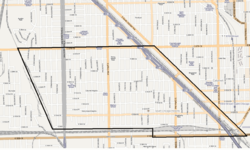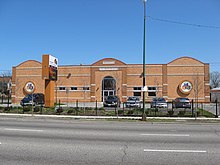Calumet Heights, Chicago
Calumet Heights | |
|---|---|
| Community Area 48 - Calumet Heights | |
 | |
 Location within the city of Chicago | |
| Coordinates:41°43′42″N87°34′47″W/ 41.72833°N 87.57972°W | |
| Country | United States |
| State | Illinois |
| County | Cook |
| City | Chicago |
| Neighborhoods | list
|
| Area | |
| • Total | 1.77 sq mi (4.58 km2) |
| Population (2020) | |
| • Total | 13,088 |
| • Density | 7,400/sq mi (2,900/km2) |
| Demographics2015[1] | |
| •White | 2.24% |
| • Black | 93.47% |
| • Hispanic | 3.23% |
| • Asian | 0.04% |
| • Other | 1.03% |
| Time zone | UTC-6(CST) |
| • Summer (DST) | UTC-5(CDT) |
| ZIP Codes | parts of 60617, 60619 |
| Median household income | $49,923[1] |
| Source: U.S. Census, Record Information Services | |
Calumet Heights,located on theSouth Sideof the city, is one of the 77 well definedcommunity areasofChicago, Illinois.Calumet Heights is bounded by 87th Street on the north, South Chicago Avenue on the east, and railroad lines on the west and south (along 95th Street).
History[edit]
Calumet Heights was swampy and relatively unoccupied throughout the nineteenth century. In 1870, the Calumet and Chicago Canal Dock Company purchased the Stony Island Ridge.[2]A railroad was built in 1881 along the western border of Calumet Heights leading to the development of the neighborhood.[3]The area became part of the Village of Hyde Park in 1889. Shortly thereafter,Hyde Park Townshipwas annexed byChicago.[2]
During theChicago Freedom Movement,Calumet Heights was one of the few areas in whichMartin Luther King Jr.received a positive reception in which he was hosted by a Calumet Heights business owner. During this same period, Dr. King was hit with a brick during a march in a white-majority area of Chicago.[4][5]
Demographics[edit]
The area that is now Calumet Heights was initially settled by Irish and German immigrants. Those residents were eventually replaced by Italian, Polish and Yugoslavian immigrants. In the 1960s, the firstAfrican Americanfamilies moved to Calumet Heights and received a hostile reception. Unlike other communities that underwent white flight during this period, Calumet Heights maintained much of its wealth.[6]As of 2015, the median income in Calumet Heights is slightly greater than that of Chicago at-large. This includes a greater percentage of Calumet Heights residents making $75,000 to $149,999 than Chicago at-large.[1]
According to a 2017 analysis by theChicago Metropolitan Agency for Planning,there were 13,732 people and 5,369 households in Calumet Heights. The racial makeup of the area was 2.2%White,93.5%African American,and 1.0% fromother races.Residents who self-identify asHispanicorLatinoof any race were 3.2% of the population. In the area, the population was spread out, with 20.1% under the age of 19, 13.3% from 20 to 34, 20.6% from 35 to 49, 21.9% from 50 to 64, and 24.2% who were 65 years of age or older. The median age was 46 years.[1]
| Census | Pop. | Note | %± |
|---|---|---|---|
| 1930 | 7,343 | — | |
| 1940 | 7,417 | 1.0% | |
| 1950 | 9,349 | 26.0% | |
| 1960 | 19,352 | 107.0% | |
| 1970 | 20,123 | 4.0% | |
| 1980 | 20,505 | 1.9% | |
| 1990 | 17,453 | −14.9% | |
| 2000 | 16,014 | −8.2% | |
| 2010 | 16,431 | 2.6% | |
| 2020 | 13,088 | −20.3% | |
| [7][8] | |||
Economy[edit]
An analysis by theUniversity of Illinois at Chicago'sGreat Cities Institute estimates there are 2,327 jobs in the Calumet Heights community area.[9]The top employingindustry sectorin the Calumet Heights area is healthcare (58.7%). Healthcare is followed by accommodation and food (12.1%), retail trade (8.4%), administration (3.6%) and other service (3.5%). Over half of the workers in these fields reside outside ofChicago.[1]56% of Calumet Heights residents are in the labor force. 83% of those are considered to be employed and 17% to be unemployed.[1]The top 5 employing industry sectors of community residents are healthcare (18.5%), education (14.1%), public administration (9.8%), administration (8.4%) and retail trade (8.2%). Over one third of Calumet Heights residents commute to Chicago's central business district and a little less than one third of Calumet Heights residents commute outside ofChicago.[1]
The Commercial Avenue TIF district is partially located in Calumet Heights.[10]Calumet Heights also includes a portion of Chicago Enterprise Zone 3. An enterprise zone is an economic development tool created by state statute which allows for various tax exemptions on activities related to development, including an exemption on taxes paid on building materials.[11][12]
Education[edit]

Calumet Heights is part ofCity of Chicago School District #299andCity Colleges of Chicago District #508.The nearest City Colleges campus wasOlive–Harvey CollegeinPullman.A high school diploma had been earned by 88.5% of Calumet Heights residents and a bachelor's degree had been earned by 27.4% of residents.[1]TheBronzeville Children's Museum,the onlychildren's museumin the United States focused onAfrican-American historymoved to Calumet Heights fromEvergreen Park, Illinoisin the early 2000s.[13]
Geography[edit]
Calumet Heights is bounded by 87th Street on the north, South Chicago Avenue on the east, and railroad lines on the west and south (along 95th Street). It includes theneighborhoodsof Calumet Heights,Pill Hill,and Stony Island Heights.[2]Beginning at about 91st Street and Constance Avenue is the geographical feature for which it was named, a stony hill that was once anislandwhen glacialLake Chicagocovered the area thousands of years ago. Early pioneers gave this hill the nameStony Islandbecause at a distance it looked like an island in set a tracklessprairiesea. (See also the nearbyBlue Island).
Politics[edit]
Calumet Heights is a stronghold for theDemocratic Party.In the2016 presidential election,Calumet Heights cast 7,840 votes forHillary Clintonand cast 184 votesDonald Trump.Despite this landslide victory, it was actually Clinton's 20th largest margin of victory by percentage points in the 76 community areas she won.[14]In the2012 presidential election,Calumet Heights cast 8,727 votes forBarack Obamaand 95 votes forMitt Romney.It was Obama's 18th largest margin of victory by percentage points in the 76 community areas he won.[15]
At the local level, Calumet Heights is located in Chicago's 7th, 8th, and 10th represented by DemocratsGregory Mitchell,Michelle A. Harris,andSusie Sadlowski Garzarespectively.[16][17][18]
Notable people[edit]
- Dorothy A. Brown,Clerk of the Circuit Court of Cook County(2000–present)[19]
- Common,rapper, actor, and winner of theAcademy Award for Best Original SongforGlory.He was raised in Calumet Heights.[20]
- Greg Mitchell,Alderman from Chicago's 7th ward. He is a longtime resident of Calumet Heights.[21]
References[edit]
- ^abcdefgh"Community Data Snapshot - Calumet Heights"(PDF).cmap.illinois.gov.MetroPulse.RetrievedNovember 28,2017.
- ^abcKouri, Charles (November 22, 1991). "Upwardly mobile Calumet Heights a 'high-end' community".Chicago Tribune– viaProQuest.
- ^Encyclopaedia Chicago: Calumet Heights
- ^Howard, Robert (May 4, 2007)."Soul Queen - Helen Maybell Anglin's legendary buffet fed everyone from Ali to MLK".Chicago Sun-Times.Chicago, Illinois.RetrievedApril 16,2018– viaNewsBank.
- ^Isserman, Maurice; Kazin, Michael (2000).America Divided: The Civil War of the 1960s.Oxford University Press. p.200.ISBN0-19-509190-6.See also:Miller, Keith D. (1998).Voice of Deliverance: The Language of Martin Luther King Jr. and Its Sources.University of Georgia Press. p. 139.ISBN0-8203-2013-7.
- ^White, John C. (February 6, 1983). "A neighborhood success story: Community changes color, but remains stable".Chicago Tribune.p. 5 – viaProQuest.
- ^"Community Data Snapshot - Calumet Heights"(PDF).cmap.illinois.gov.MetroPulse.RetrievedNovember 28,2017.
- ^Paral, Rob."Chicago Community Areas Historical Data".Archived fromthe originalon March 18, 2013.RetrievedAugust 30,2012.
- ^"Economic Fact Sheet #1: Chicago and Cook County Economic Trends"(PDF).University of Illinois Chicago.July 11, 2016.RetrievedJuly 12,2017.
- ^"Commercial Avenue TIF".City of Chicago Department of Planning and Development.RetrievedJanuary 3,2018.
- ^"Chicago III (2016)"(PDF).Illinois Department of Commerce and Economic Opportunity. January 23, 2018. Archived fromthe original(PDF)on April 17, 2018.RetrievedApril 17,2018.
- ^"Illinois Enterprise Zone Act (20 ILCS 655/)".Illinois General Assembly.February 28, 1990.RetrievedApril 16,2018.
- ^Patterson, Melissa (August 19, 2008)."Museum a place for kids to learn; African-American history and culture the focus of Far South Side institution that just keeps growing".Chicago Tribune.p. 2.ProQuest420731623.
- ^Ali, Tanveer (November 9, 2016)."How Every Chicago Neighborhood Voted In The 2016 Presidential Election".Chicago, Illinois:DNAinfo.com.Archived fromthe originalon March 17, 2017.RetrievedMarch 16,2017.
- ^Ali, Tanveer (November 7, 2012)."How Every Chicago Neighborhood Voted In The 2012 Presidential Election".Chicago, Illinois:DNAinfo.com.Archived fromthe originalon March 17, 2017.RetrievedMarch 16,2017.
- ^Connolly, Colleen (February 6, 2015)."Get to Know Your Ward: 7th Ward".Ward Room.WMAQ-TV.RetrievedDecember 25,2017.
- ^Connolly, Colleen (February 6, 2015)."Get to Know Your Ward: 8th Ward".Ward Room.WMAQ-TV.RetrievedDecember 27,2017.
- ^Connolly, Colleen (February 6, 2015)."Get to Know Your Ward: 10th Ward".Ward Room.WMAQ-TV.RetrievedDecember 27,2017.
- ^Nickeas, Peter (February 23, 2019)."Blaze strikes Clerk Dorothy Brown's home".Chicago Tribune.RetrievedFebruary 23,2019.
- ^Bazer, Mark (September 17, 2014)."Common is Back in the Neighborhood".No. October 2014. Chicago magazine.
- ^Mitchell, Greg (March 20, 2015)."Greg Mitchell - Office running for: Alderman, 7th Ward"(Interview). Interviewed by Chicago Sun-Times Editorial Board.Chicago, Illinois:Chicago Sun-Times.RetrievedDecember 27,2018.
